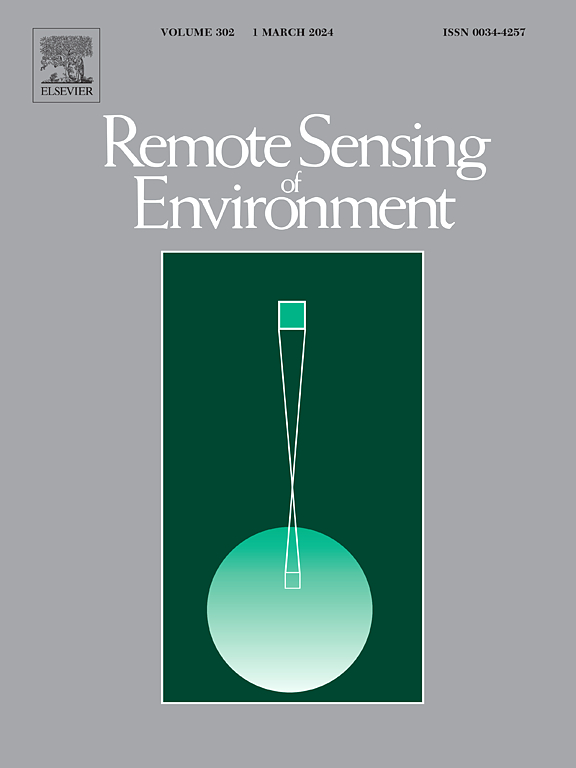MODIS蒸散发算法在热带生物群系全天空条件下的增强与时空改进
IF 11.1
1区 地球科学
Q1 ENVIRONMENTAL SCIENCES
引用次数: 0
摘要
在 MOD16 蒸发蒸散(ET)算法的基础上,我们开发了一种用于热带地区局部到区域蒸散监测和应用的蒸散模型,即 MODIS 蒸发蒸散时空改进模型(ESTIMET)。ESTIMET的主要特点是提供近实时产品,提高空间分辨率(从500米提高到250米)和时间分辨率(从8天提高到每天),最大限度地减少云层间隙,并调整不同植被和小气候类型的具体热带特征。我们利用巴西 14 个站点的涡度协方差(EC)数据以及巴西 25 个流域基于水平衡的年蒸散发量,比较了 ESTIMET 与 MOD16A2GF、PML_V2 和 GLEAM 4.1a 蒸散发产品的结果。总体而言,ESTIMET 估算值捕捉到了 EC 数据的日季节变化,尤其是在 Caatinga、Pantanal 和 Cerrado 生物群落,在这三个生物群落的 8 个站点的一致性相关系数(ρc)从 0.45 到 0.80 不等。8 天累积蒸散发的比较表明,ESTIMET 算法的平均 ρc 值为 0.63,高于 MOD16A2GF(ρc = 0.58)、GLEAM 4.1a(ρc = 0.47)和 PML_V2(ρc = 0.45)。同样,在南美三大生物群落(亚马逊、大西洋森林和塞拉多)的流域水量平衡中,ESTIMET 比其他蒸散发产品更好地反映了年蒸散发量,这三个生物群落覆盖了巴西 85% 以上的领土。因此,在所有天空条件下,ESTIMET 在更精细的时空尺度和延迟(即月度)上运行,改进了热带生物群落中基于遥感的蒸散发估算。本文章由计算机程序翻译,如有差异,请以英文原文为准。
ESTIMET: Enhanced and Spatial-Temporal Improvement of MODIS EvapoTranspiration algorithm for all sky conditions in tropical biomes
We developed an ET model, namely the Enhanced and Spatial-Temporal Improvement of MODIS EvapoTranspiration (ESTIMET), for local-to-regional ET monitoring and applications in the tropics, based on the original MOD16 evapotranspiration (ET) algorithm. The main distinguishing features of ESTIMET are providing a near-real-time product with increased spatial (from 500 to 250 m) and temporal (from 8-day to daily) resolutions, minimising gaps in cloud cover and adjusting specific tropical characteristics of diverse vegetation and microclimate types. We compared the results of ESTIMET with the MOD16A2GF, PML_V2, and GLEAM 4.1a ET products, using eddy covariance (EC) data from 14 sites in Brazil, as well as the water balance-based annual ET in 25 Brazilian catchments. Overall, the ESTIMET estimates captured the daily seasonal variations of the EC data, especially in the Caatinga, Pantanal, and Cerrado biomes, with concordance correlation coefficients (ρc) ranging from 0.45 to 0.80 at eight sites located in these three biomes. The comparisons of the 8-day cumulative ET show that the ESTIMET algorithm exhibits a mean ρc of 0.63, greater than that of MOD16A2GF (ρc = 0.58), GLEAM 4.1a (ρc = 0.47), and PML_V2 (ρc = 0.45). Similarly, for the catchment water balance, ESTIMET exhibits a better representation of annual ET than other ET products in the three major South American biomes, i.e. the Amazon, Atlantic Forest, and Cerrado, which cover over 85 % of the Brazilian territory. Thus, ESTIMET improves remote sensing-based ET estimates in tropical biomes, operating at a finer spatiotemporal scale and latency (i.e. monthly) under all sky conditions.
求助全文
通过发布文献求助,成功后即可免费获取论文全文。
去求助
来源期刊

Remote Sensing of Environment
环境科学-成像科学与照相技术
CiteScore
25.10
自引率
8.90%
发文量
455
审稿时长
53 days
期刊介绍:
Remote Sensing of Environment (RSE) serves the Earth observation community by disseminating results on the theory, science, applications, and technology that contribute to advancing the field of remote sensing. With a thoroughly interdisciplinary approach, RSE encompasses terrestrial, oceanic, and atmospheric sensing.
The journal emphasizes biophysical and quantitative approaches to remote sensing at local to global scales, covering a diverse range of applications and techniques.
RSE serves as a vital platform for the exchange of knowledge and advancements in the dynamic field of remote sensing.
 求助内容:
求助内容: 应助结果提醒方式:
应助结果提醒方式:


